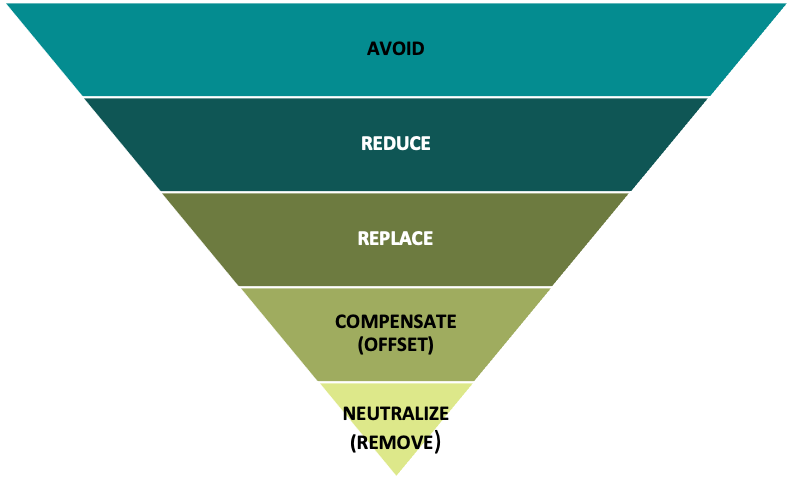Greenhouse Gas Mitigation Hierarchy

1. Traditional Energy Conservation Measures (Avoid and Reduce)
The first two tiers of the Greenhouse Gas (GHG) Mitigation Hierarchy are critical to lessening Columbia’s impact on a wide range of limited resources, as well as attainment of GHG reduction goals. “Avoid” refers to measures that avoid creating impacts in the first place, and “Reduce” refers to measures that reduce the intensity and/or extent of impacts that cannot be completely avoided. Prioritizing Columbia’s actions to Avoid and Reduce GHG emissions above deploying resources to “Replace” emissions will ensure the most effective path toward achieving science-based targets (SBT).
Columbia’s prior and current initiatives to Avoid and Reduce will continue and expand to address the following areas:
- New building & retro-commissioning standards
- Electricity-related improvements in efficiency (e.g., lighting programs)
- Fuel-related improvements in efficiency (e.g., chilled water systems and steam piping insulation projects)
2. Long-Term Renewable Energy Supply (Replace)
Columbia started purchasing renewable electricity in 2014 in the form of hydropower from the New York Power Authority (NYPA). In 2018, Lamont-Doherty Earth Observatory (LDEO) started meeting a portion of its electricity requirements from two dedicated, off-site solar facilities. Also starting in 2018 and continuing each year through annual procurement, Columbia neutralized its emissions for purchased electricity by supplementing NYPA hydropower and LDEO solar with National renewable energy credits (RECs). From inception, Columbia determined to employ National RECs to offset emissions from purchased electricity only until viable alternatives for physically “delivered” bundled renewable electricity (power plus environmental attributes) became available. In 2018, a renewable electricity study was conducted to outline steps to advance a long-term strategic transition from brown power to renewable electricity resources.
A core working group will help curate a strategy to procure 100% zero emission electricity that considers the areas of opportunity outlined below. Additionally, the strategy will address the items below as short-term (0-3 year), mid-term (4-10 year), and long-term options, and inform a cohesive, integrated approach, where electricity, fuel, and infrastructure strategies combine to ensure the University will align with its science-based target trajectory starting in 2021.
Wholesale & Retail Energy Markets
- Explore market options to purchase renewable energy products including physical zero emissions electricity, source specific RECs, and regional (e.g., NYS offshore wind) renewable electricity.
On-Site Renewable Electricity Generation
- Explore opportunities identified in the electrification request for proposal (RFP) study to implement demonstration projects, and those of productive scale, of on-campus renewable electricity generation alternatives that demonstrate technology application and reduce power importation requirements.
- Work to fully vet the feasibility of installing just over 1 megawatt (MW) of solar power at the Nevis Campus and utilize the net metering tariff options to offset Morningside campus electricity loads.
Off-Site Renewable Electricity Generation
- Evaluate the Champlain Hudson Power Express (CHPE) opportunity once contract terms are released. In Fall 2019, Columbia signed a non-binding term sheet with the project developer to ensure a retail block was held for negotiations. CHPE is a fully permitted project that will bring up to 1,250 MW of clean, renewable power to the New York metro area.
- Develop and issue an RFP seeking creative solutions for offsite power purchase agreements (PPAs), virtual PPAs, source-specific RECs, and community solar both within Columbia's grid zone and outside of it.
- Actively seek out best practices to secure PPAs for the output of offsite renewable resources, either for Columbia as an individual location or within an aggregation of multiple purchasers together, as has been done by peer organizations. This could include evaluation of off-shore wind, and upstate solar and wind developments.
New York State Grid
- Monitor ongoing developments to decarbonize the New York State grid as per the state mandate for 70% renewable electricity by 2030 and a carbon free grid power supply by 2040, as determined in the landmark New York State Climate Leadership and Community Protection Act (CLCPA) passed in 2019.
RECs (Offset)
- Continue strategic direction to phase out use of National RECs.
- Through 2023: Short-term, interim strategy to purchase National RECs to offset remaining emissions from purchases of grid brown power.
- Beginning in 2023 or sooner (depending on availability of market options), transition to a medium to longer term strategy that utilizes Tier 4 RECs (representing new supplies of renewable electricity physically delivered into NYC) to cover any area that is not otherwise addressed with one of the above items.
Click here to read more about Columbia’s Zero Emission Electricity strategy.
3. Strategic Electrification (Reduce and Replace)
Strategic electrification is part of an integrated approach for deep decarbonization at Columbia. Strategic electrification means transitioning the “CEPSR buildings,” as defined below, from fossil fuel burning heating and cooling technologies while simultaneously increasing building and system efficiency.
To decrease the negative environmental impacts of its operations, particularly GHG emissions, Columbia University is seeking a detailed understanding of how the strategic electrification of its facilities can contribute to University sustainability targets and decarbonization mandates set by New York City and New York State.
The focus of the initial study will be the 65 Morningside campus buildings served by the Morningside central heating and cooling plants, as well as the plants themselves. Together, these buildings are responsible for approximately 60% of the total Morningside+ Scope 1 emissions. Most of these buildings (62 out of 65) receive steam from the Columbia Powerhouse which is in the Shapiro Center for Engineering and Physical Science Research and referred to as “CEPSR”. Accordingly, the buildings will be referred to as the “CEPSR buildings.”
The study will encompass all 65 CEPSR buildings, associated central and distributed energy supply facilities, as well as interconnected electric and natural gas distribution assets. Within this boundary, the study will include assessments of conventional and deep energy conservation potential, approaches for electrifying building heating and cooling, and on-site renewable electricity generation potential.
At the conclusion of the study, Columbia will possess a Strategic Electrification Masterplan for the CEPSR buildings which describes a detailed roadmap for:
- Meeting Columbia’s commitments under the NYC Carbon Challenge
- Complying with regulatory mandates including LL97 carbon intensity limits
- Meeting science-based carbon budget and emission reductions targets aligned with a 1.5oC global temperature threshold as defined in Plan 2030
- Achieving net zero emissions
The study results will inform next steps with respect to the potential for strategic electrification to be deployed at other Columbia facilities. Strategic electrification would likely result in a greatly expanded demand for electricity. Accordingly, Columbia’s efforts to understand renewable electricity supply options will provide key input assumptions to the electrification study and its conclusions.
4. Renewable Fuel (Replace)
A significant portion of thermal operations and process application within Columbia buildings and laboratories are expected to have viable replacement options, such as electrification of central steam plant facilities that consume natural gas and fuel oil.
For other applications, however, electrification may be exceedingly difficult or costly, or electrified alternatives may not adequately address the energy use type (e.g., research and testing that require open flame or business continuity and emergency power generation requiring combustible fuels). In those instances where a specific and required application cannot be adequately electrified and consumption of fuel may be warranted, either temporarily until a non-combustion option is available or permanently due to process requirements, renewable fuels may provide an alternative. One example of a non-emitting renewable fuel with significant current focus in U.S. markets as well as New York is “green hydrogen.” Created using non-emitting renewable electricity, it is under study and in very early stages of commercialization worldwide as of the release of Plan 2030. The progress of renewable fuel development, such as green hydrogen, will continue to be monitored for progress toward commercialization and applicability for Columbia’s purposes.
